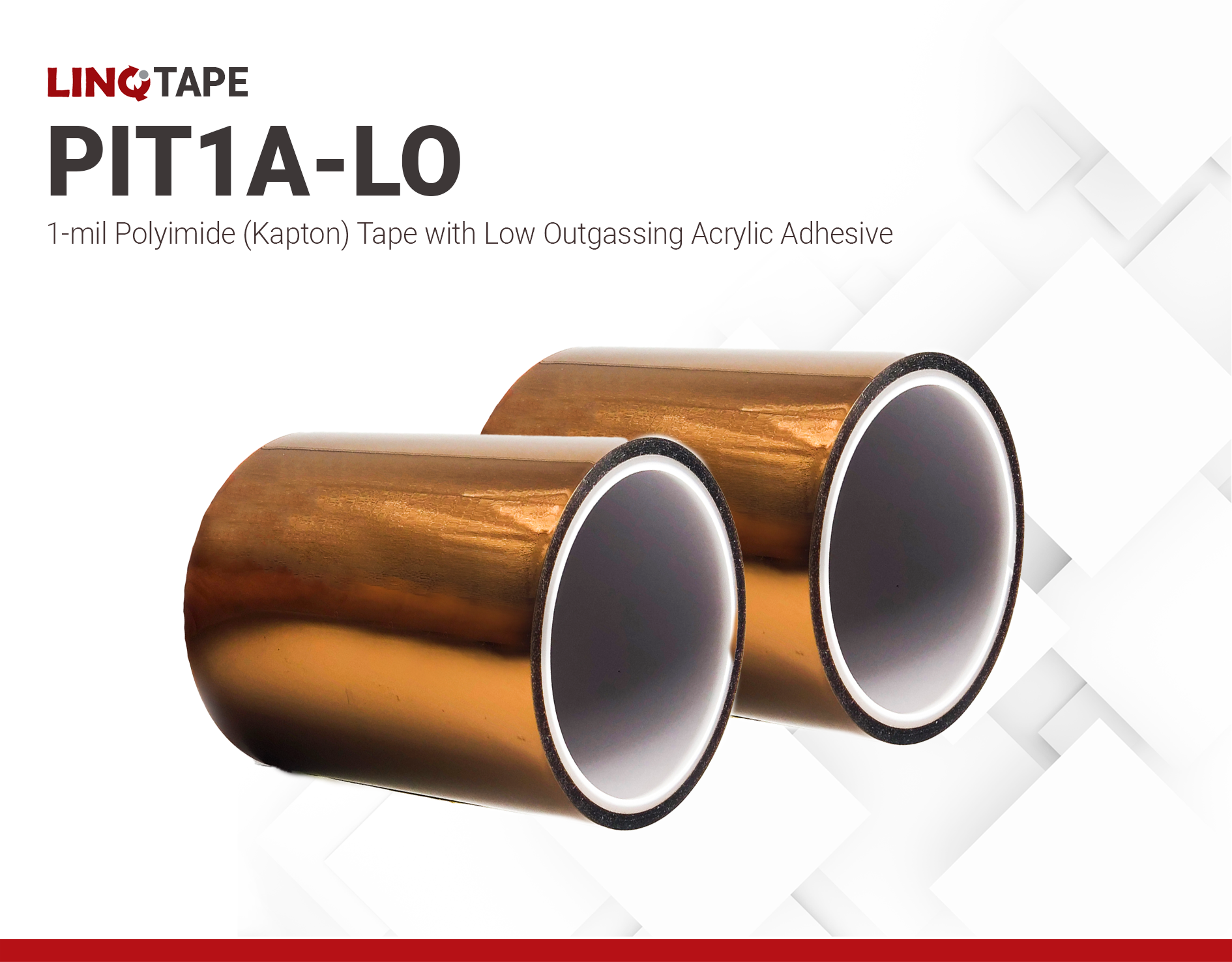PIT1A-LO | 1-mil Polyimide (Kapton) Tape with Low Outgassing Acrylic Adhesive
- 1 mil polyimide film
- Non-silicone, low outgassing acrylic adhesive
- >6000V breakdown voltage
Product Description
LINQTAPE™ PIT1A-LO is an amber high-temperature resistant polyimide film designed for both permanent and temporary bonding in many high-temperature applications. These applications can be found in semiconductor, smartcard, electronic, automotive and aerospace industries. Its low outgassing properties make it a perfect solution for sensitive applications. It has a 1mil backing thickness and 1.5 mil acrylic adhesive. This tape has less than 1% TML and less than 0.1% CVCM values, making it suitable for aerospace applications.
LINQTAPE™ PIT1A-LO has good adhesion and tensile strength and can operate in temperatures between -29°C to 177°C. It comes in 33 meter (36 yard) rolls of varying widths. LINQTAPE PIT-A polyimide films with acrylic adhesive are available in a range of thicknesses, starting from 0.5 mil (12.7µm) thickness and up. Custom thicknesses are available upon request.
Technical Specifications
| General Properties | |
| Adhesive Layer Adhesive Layer A layer that is applied to one surface or both to bind items together and resist their separation | Acrylic |
| Adhesive Thickness Adhesive Thickness Adhesive thickness indicates the thickness of an adhesive layer. It refers to the adhesive thickness of a single side so for double sided tapes it always needs to be multiplied. | 50.8 µm |
| Color Color The color | Amber |
| Film Thickness Film Thickness Film thickness is the thickness of a backing film without taking into account any coatings or adhesive layers. It is measured in micron and the conversion factor to mil is 0.039. | 25.4 µm |
| Release Liner Release Liner A paper or plastic-based film sheet used to prevent a sticky surface from prematurely adhering | None |
| Single or Double-Sided Adhesive Single or Double-Sided Adhesive Describes whether a tape is single- or double-sided. If it is single-sided, it has adhesive only on one side of the backing film. If it is double-sided, then it has adhesive on both sides of the backing film. | Single |
| Total Thickness Total Thickness Total thickness is taking into account all the films, coatings, adhesives, release liners and special layers and is the maximum thickness of a film or tape. | 76.2 μm |
| Thermal Properties | |
| Temperature Resistance Temperature Resistance Temperature resistance is the maximum temperature that the material or product can withstand for a period of time. The temperatures listed should be considered as guidelines for an operating temperature of about 30 minutes. Typically, the material can withstand much longer times at temperatures about 20°C lower and can withstand much higher temperatures for short, intermittent times. | -30 to 175 ˚C |
| Electrical Properties | |
| Breakdown Voltage Breakdown Voltage Breakdown voltage is the minimum voltage necessary to force an insulator to conduct some amount of electricity. It is the point at which a material ceases to be an insulator and becomes a resistor that conducts electricity at some proportion of the total current. After dielectric breakdown, the material may or may not behave as an insulator any more because of the molecular structure alteration. The current flow tend to create a localised puncture that totally alters the dielectric properties of the material. This electrical property is thickness dependent and is the maximum amount of voltage that a dielectric material can withstand before breaking down. The breakdown voltage is calculated by multiplying the dielectric strength of the material times the thickness of the film. | 6500 V |
| Mechanical Properties | |
| Adhesion Strength Adhesion Strength Adhesion is the bond strength measurement of a coating to a substrate. When an adhesive is bonded to an item or surface, numerous physical, mechanical and chemical forces come into play, which may have an effect on each other. | 50 Oz/in |
| Elongation Elongation Elongation is the process of lengthening something. It is a percentage that measures the initial, unstressed, length compared to the length of the material right before it breaks. It is commonly referred to as Ultimate Elongation or Tensile Elongation at break. | 55 % |
| Tensile Strength (Thin Film) Tensile Strength (Thin Film) Tensile strength determines the resistance of a material to break under tension and it measures how much elongating load (or tensile stress) it can handle before fracture. To make it simple, it measures how much force we have to apply when pulling apart a material before it breaks. | 53 N/cm |



